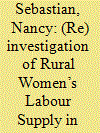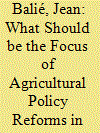|
|
|
Sort Order |
|
|
|
Items / Page
|
|
|
|
|
|
|
| Srl | Item |
| 1 |
ID:
170361


|
|
|
|
|
| Summary/Abstract |
This article examines the role of household poverty in shaping rural female labour supply using the unique panel dataset of India Human Development Survey. The results using Vella and Verbeek’s two-step panel estimation reveal the presence of a backward-sloping labour supply curve for rural women from below poverty line households, and an upward-sloping labour supply for rural women from above poverty line (APL) households. This implies the existence of ‘forced’ or ‘need-based’ participation among poor women and justifies why they work long hours in poorly paid hazardous jobs. The article also finds horizontal labour supply among agriculture wage workers and for Adivasi and Dalit rural women to some extent, reflecting limited job options, and surplus unskilled labour who are unable to demand higher wages for their labour supply. On the other hand, when categorised by occupation type, the downward-sloping labour supply for rural women from APL households indicates the dominance of the income effect over the substitution effect, and the socio-cultural factors that gain strength as income levels increase.
|
|
|
|
|
|
|
|
|
|
|
|
|
|
|
|
| 2 |
ID:
170358


|
|
|
|
|
| Summary/Abstract |
This study aims at measuring the technical efficiency of banks in India and examining its determinants. Efficiency is said to be achieved if a bank is able to maximise its output subject to limited inputs. To obtain technical efficiency score, input-oriented Malmquist Data Envelopment Analysis is applied on two outputs and three input variables, based on a VRS (variable returns to scale) assumption. Three foreign banks—namely, A B Bank Ltd, Bank of Ceylon, and Citibank N A—and two Indian banks—namely, HDFC Bank and State Bank of India—are found to be most efficient during the study period. The efficiency scores when subsequently used as the dependent variable along with independent variables—bank size, capitalisation, liquidity risk, returns on assets, interest rate, credit risk, market concentration and gross domestic product (GDP)—in a panel regression analysis found the fixed effect model to be more appropriate in explaining the determinants. The results reveal that liquidity risk, returns on assets, credit risk, market concentration and GDP have a significant effect on the technical efficiency, while banks size, interest rate and level of capitalisation are found to be insignificant variables.
|
|
|
|
|
|
|
|
|
|
|
|
|
|
|
|
| 3 |
ID:
170359


|
|
|
|
|
| Summary/Abstract |
This article aims to estimate a forward-looking reaction function for the Central Bank of the Republic of Turkey (CBRT) considering possible asymmetries in the reaction function. For this purpose, it uses quarterly data over the period 2006:1–2018:1 and performs the nonlinear autoregressive distributed lag (NARDL) cointegration test. The findings obtained from the NARDL test indicate that the CBRT has an asymmetric reaction function and considers increases in inflation and decreases in output while adjusting short-term interest rates. Theoretical and practical implications for these findings are also discussed.
|
|
|
|
|
|
|
|
|
|
|
|
|
|
|
|
| 4 |
ID:
170360


|
|
|
|
|
| Summary/Abstract |
While a lot of research has been conducted on agricultural subsidies and other forms of policy transfers in developed and developing countries alike, substantial data constraints have characterised those conducted in developing countries. For this study, we employ a novel and uniquely developed dataset on these policies in Sub-Saharan Africa (SSA), to analyse the impact of policy reforms, using the latest available GTAP 9.1 Data Base, in the widely employed GTAP framework, for the first time. We simulate the scenarios of removal of output subsidies, removal of ‘market development gaps’ within and outside the country. Our results indicate that removing market development gaps is likely to increase the agricultural output without affecting trade much, while removing the subsidies could harm output a lot by import-substitution of the costly domestic output. We conclude that governments in SSA may do well to focus on developing their markets better rather than cutting the assistance to their farmers, which could in fact be counter-productive instead of raising the efficiency of domestic farmers through competition.
|
|
|
|
|
|
|
|
|
|
|
|
|
|
|
|
|
|
|
|
|